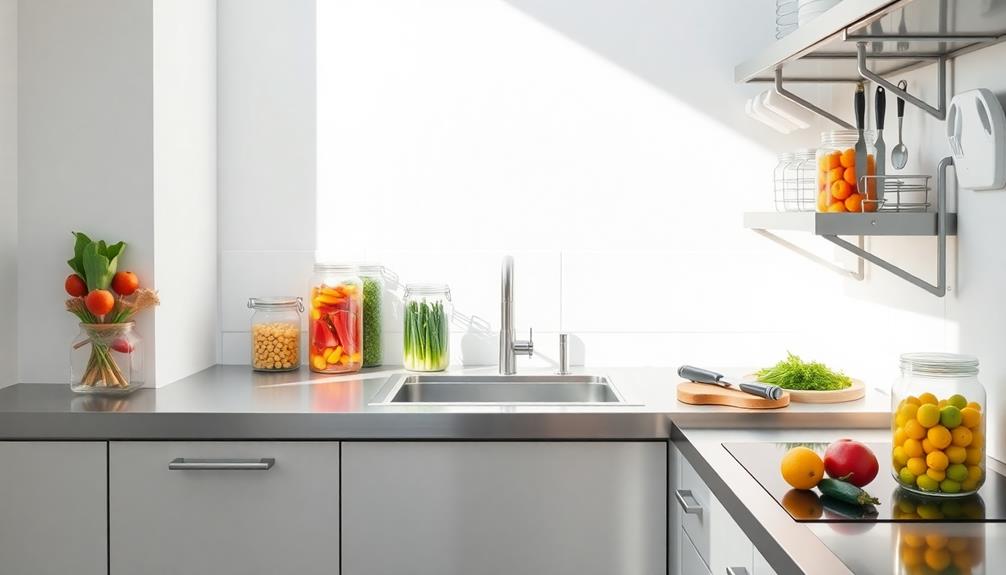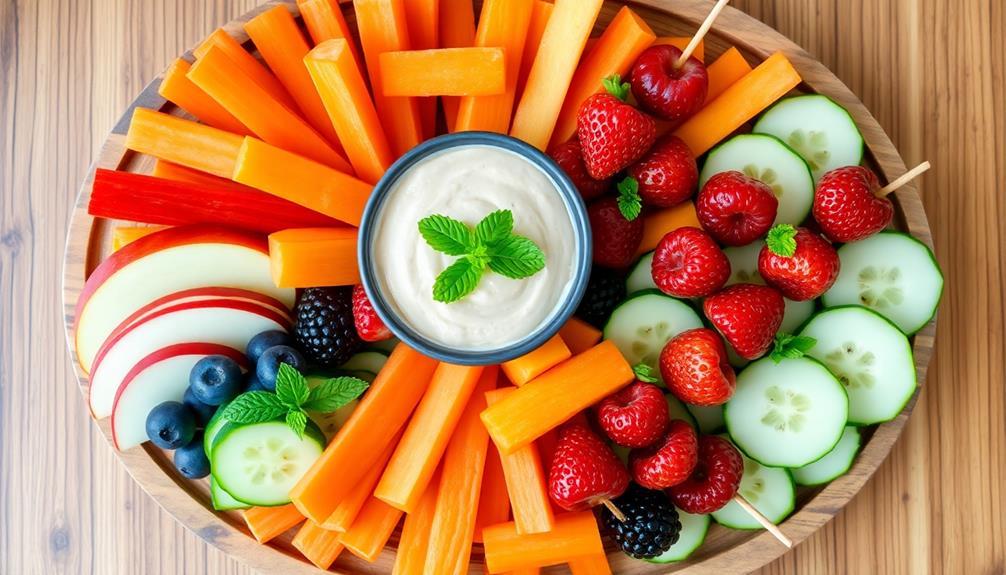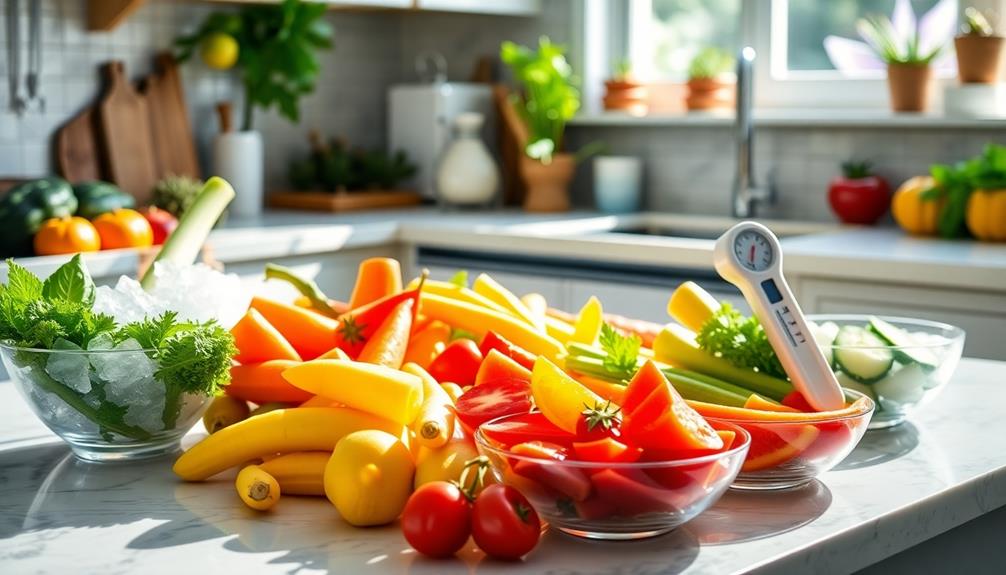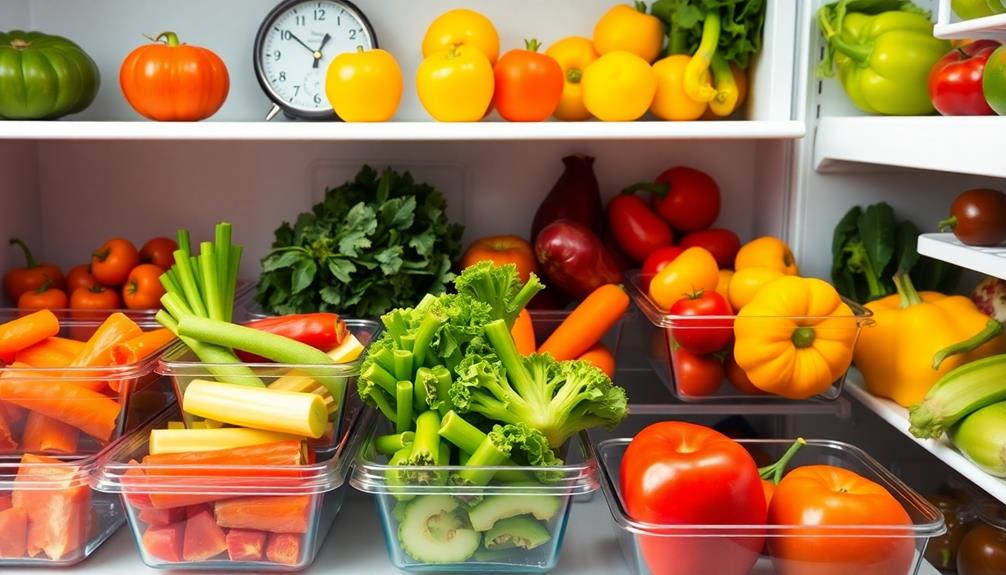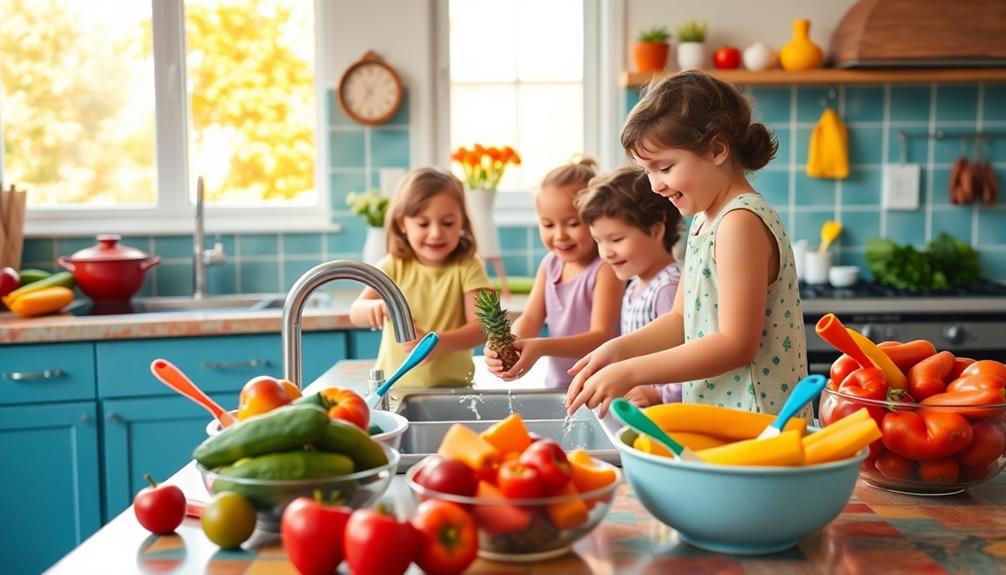When setting up a raw food kitchen, prioritize safety and efficiency to minimize contamination risks. Start by creating distinct zones for food storage, preparation, cooking, and serving while keeping raw and cooked foods separate. Ascertain your layout follows the food safety triangle—place sinks and prep areas close together for easy handwashing access. Use non-porous materials, like stainless steel, for surfaces to simplify cleaning. Equip your kitchen with accessible handwashing stations and food thermometers to maintain hygiene. Implement effective waste management and train staff regularly to enforce best practices. Discover more tips for a safe and efficient kitchen setup!
Key Takeaways
- Ensure distinct zones for raw food preparation and cooked food to minimize cross-contamination risks.
- Install easily accessible handwashing stations within four meters of prep areas to promote frequent hand hygiene.
- Utilize non-porous, easy-to-clean materials like stainless steel for surfaces to inhibit bacteria growth and facilitate sanitation.
- Implement effective ventilation systems to maintain air quality and eliminate heat and odors in the kitchen.
- Train staff regularly on food safety practices and waste management to reduce the risk of foodborne illnesses.
Importance of a Safe Kitchen
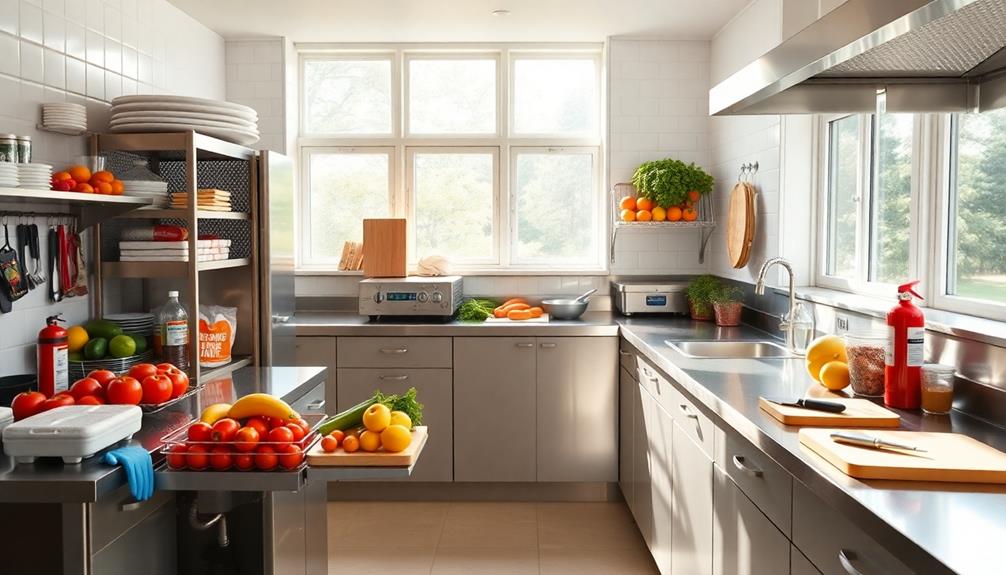
A safe kitchen sets the foundation for successful raw food preparation. To guarantee safety, you'll want to design your kitchen layout with distinct areas for raw and cooked foods. This separation is imperative to prevent cross-contamination, which can lead to foodborne illnesses.
Implementing the food safety triangle can enhance efficiency by keeping your frequently used areas, like sinks and preparation spaces, close together.
Don't forget about ventilation; installing an adequate system helps eliminate heat, odors, and airborne contaminants. This is essential for preventing mold and bacteria growth in your kitchen.
Compliance with health department regulations regarding sink requirements and workspace organization is critical for maintaining food safety standards.
Regular food safety training for your kitchen staff is necessary to keep everyone updated on best practices. This ongoing education will guarantee a consistently safe cooking environment and reduce the risk of foodborne illnesses.
Key Design Principles
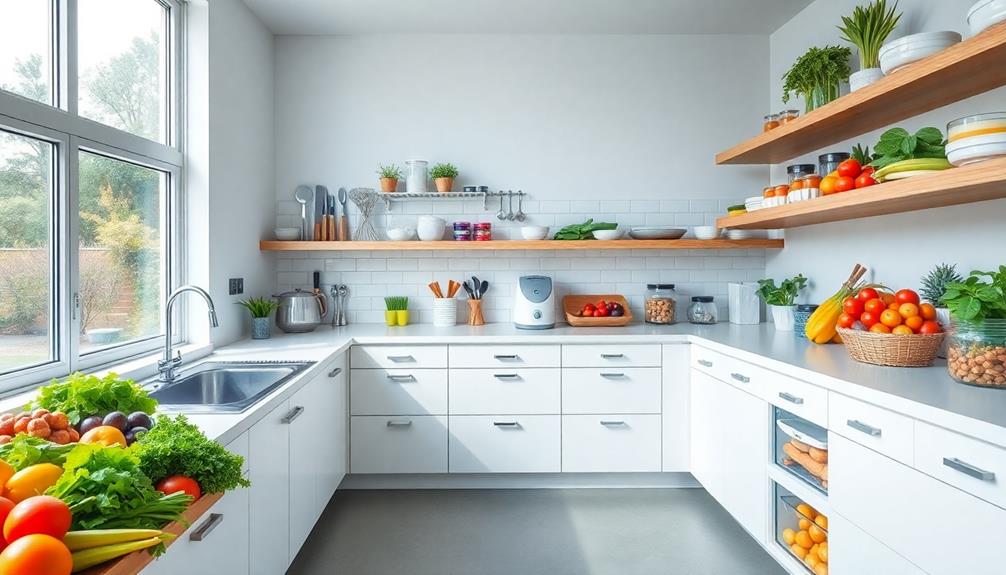
Designing a raw food kitchen requires careful consideration of several key principles to confirm efficiency and safety. By focusing on food safety and hygiene, you can create a space that promotes safe practices while enhancing your workflow.
| Design Principle | Description |
|---|---|
| Flow Optimization | Arrange the layout to minimize cross-contamination. Keep prep areas near handwashing stations within a four-meter radius. |
| Zoning | Set distinct zones for receiving, storage, preparation, and serving to keep raw and cooked ingredients separate. |
| Material Selection | Choose non-porous, easy-to-clean materials like stainless steel for surfaces, preventing bacteria growth. |
| Ventilation Systems | Confirm effective ventilation to reduce heat and odors, improving air quality and inhibiting harmful microorganisms. |
| Hand Hygiene Stations | Install accessible handwashing stations throughout the kitchen to promote frequent handwashing, essential for food safety. |
Essential Safety Equipment
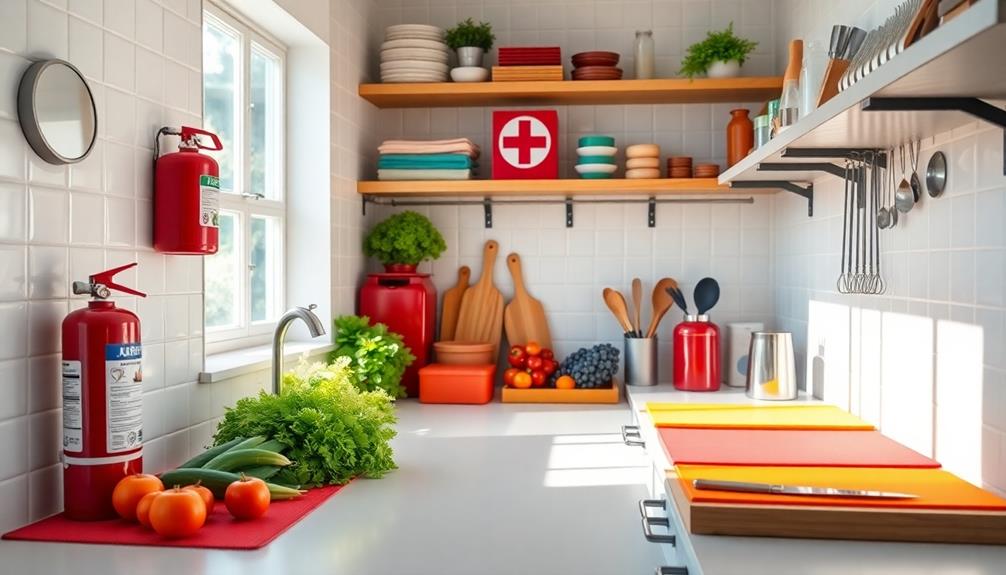
Creating a safe raw food kitchen hinges on the right safety equipment. First and foremost, you need accessible handwashing stations throughout your kitchen. Frequent handwashing is vital for maintaining hygiene practices and preventing cross-contamination during food preparation.
Next, invest in food thermometers; they're essential for guaranteeing that any food requiring heating reaches safe temperatures, minimizing the risk of foodborne illnesses.
Seal your waste effectively by using leak-proof, sealable containers. This not only keeps odors at bay but also prevents pests, contributing to a clean and safe kitchen environment.
It's equally important to choose non-porous surfaces, like stainless steel countertops, which are easy to clean and help reduce the risk of contamination.
Lastly, equip your staff with protective gear such as gloves and hair restraints. This guarantees cleanliness and prevents any contamination during food handling.
Effective Layout Strategies
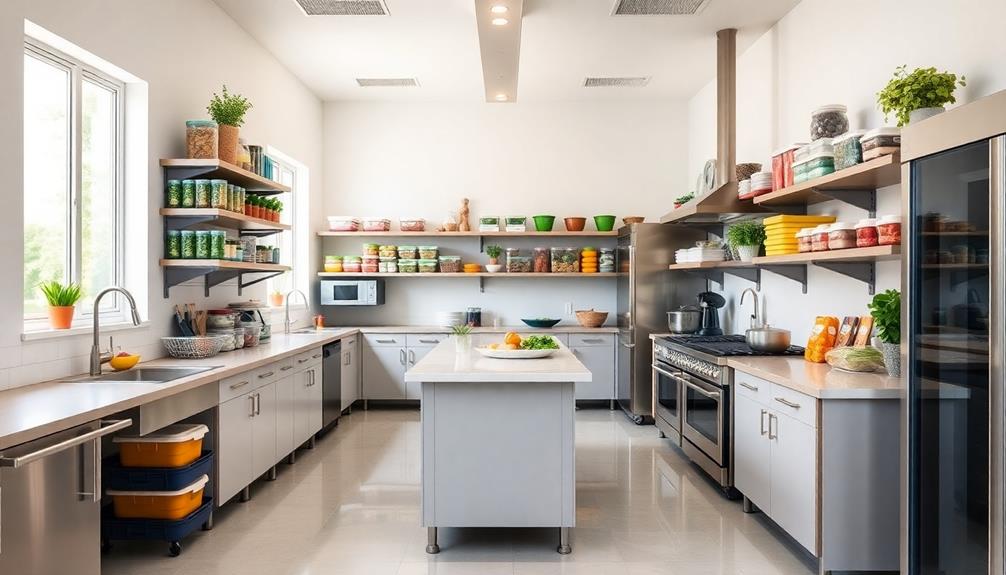
An effective raw food kitchen layout can greatly enhance your workflow and maintain food safety. By implementing effective layout strategies, you can minimize the risk of foodborne illnesses while maximizing efficiency. Start by arranging your kitchen equipment in a food safety triangle: the sink, preparation area, and stove should be within four meters of each other. This placement reduces contamination risks during food prep.
Zoning your kitchen is essential. Organize specific areas for receiving, storage, preparation, cooking, and service. This helps prevent cross-contamination and maintains a logical workflow. Also, make certain that raw food prep areas are distinctly separated from cooked food areas.
Here's a helpful overview:
| Area | Purpose | Key Features |
|---|---|---|
| Receiving | Accepting ingredients | Inspection and immediate storage |
| Storage | Keeping ingredients safe | Labeled airtight containers |
| Preparation | Preparing raw food | Easy access to tools and ingredients |
| Cooking | Preparing meals | Proximity to prep areas |
| Service | Serving food | Clear pathways for easy access |
Installing multiple handwashing stations near prep areas encourages frequent handwashing, further mitigating contamination risks.
Cleanliness and Hygiene Practices
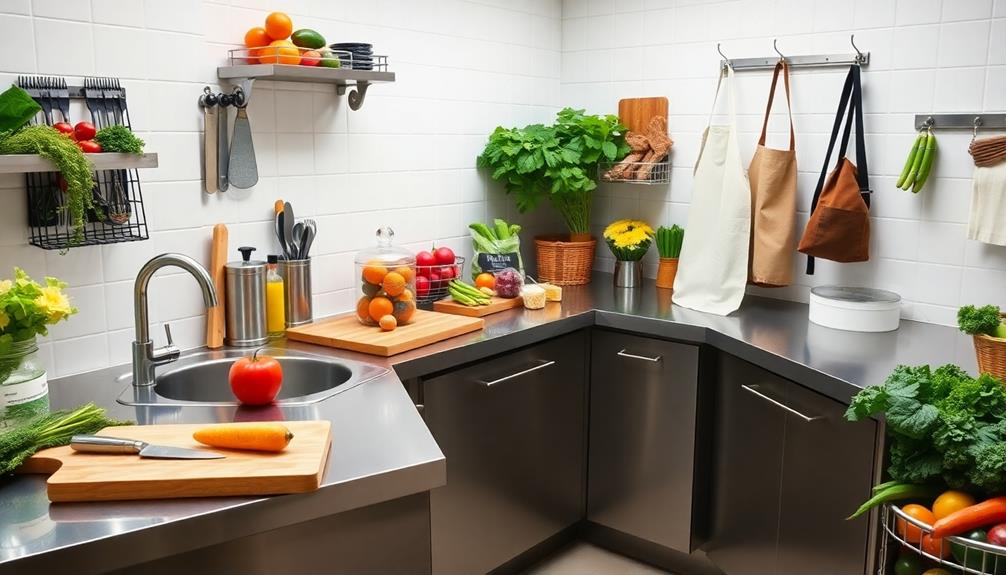
Maintaining a raw food kitchen's cleanliness is essential for guaranteeing food safety and preventing illnesses. Since domestic settings account for about 40% of foodborne illnesses, you must adopt strict hygiene practices. An important aspect of this is having handwashing stations readily accessible. Frequent handwashing is fundamental, especially considering that 5% of foodborne illnesses stem from infected food handlers.
Additionally, following a raw food diet's health benefits can help you understand the importance of cleanliness in preparing unprocessed foods.
To effectively clean and sanitize your kitchen, confirm that all surfaces and equipment are made from non-porous, easy-to-clean materials like stainless steel. This helps reduce bacteria growth and facilitates thorough sanitation.
It's also critical to implement a clear separation between raw food preparation areas and zones for cooked or ready-to-eat foods. This minimizes contamination risks, especially when handling raw meat.
Additionally, maintain proper waste management policies to prevent odors and pest attraction in your kitchen. Use leak-proof containers for waste and dispose of them regularly.
Waste Management Techniques
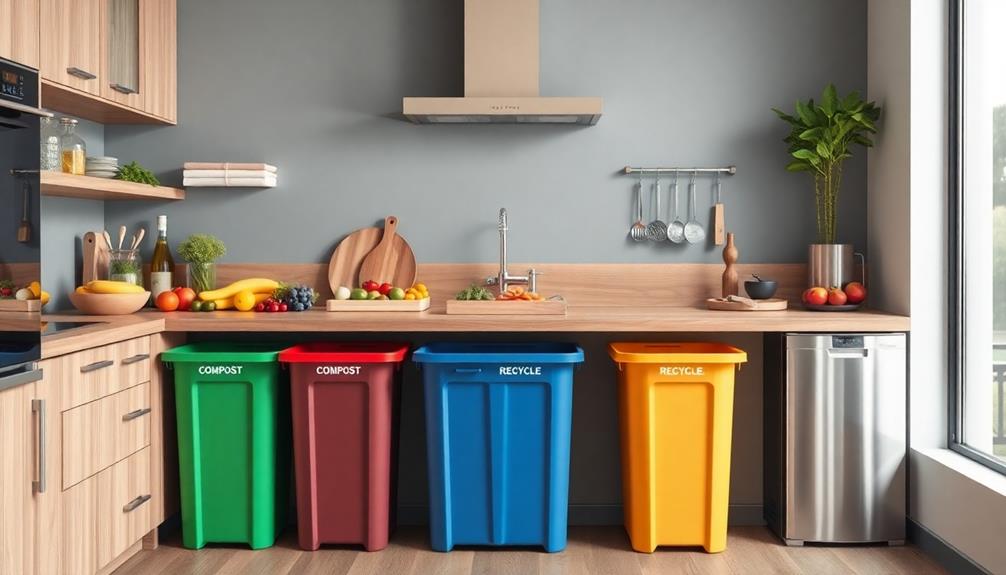
In your raw food kitchen, effective waste management starts with clear waste separation guidelines, so use labeled bins for compost, recyclables, and general waste.
Adhering to proper waste disposal methods not only helps in maintaining hygiene but also reduces food waste, which is vital for a sustainable kitchen environment.
Regularly disposing of waste is important to prevent pest attraction and maintain hygiene.
Don't forget to train your staff on proper waste handling to guarantee everyone contributes to a clean and safe kitchen environment.
For additional insights on health and safety in food preparation, refer to ultimate hamster care guide.
Waste Separation Guidelines
Establishing clear waste separation guidelines is vital for effective waste management in your raw food kitchen. By designating specific containers for organic waste, recyclables, and general waste, you'll guarantee each type is correctly disposed of, preventing contamination. Make it easy for everyone by clearly labeling each container.
Utilize leak-proof and sealable containers for storing organic waste, as this helps prevent odors and keeps pests away. This attention to cleanliness not only enhances your kitchen environment but also supports sustainability efforts. Training your kitchen staff on proper waste handling is essential; they should understand and follow the established waste policy for compliance and safety.
Here's a quick reference table to help reinforce your guidelines:
| Waste Type | Container Type | Disposal Method |
|---|---|---|
| Organic Waste | Sealable Bin | Composting |
| Recyclables | Blue Recycling Bin | Curbside Recycling |
| General Waste | Black Trash Bin | Landfill |
Encouraging composting for organic waste contributes to reducing landfill contributions, promoting a sustainable kitchen setup. With these guidelines in place, you'll create a cleaner, more efficient workspace.
Regular Disposal Schedule
To keep your raw food kitchen clean and hygienic, a regular disposal schedule is necessary. This schedule should ideally include daily waste removal to maintain hygiene standards and reduce the risk of foodborne illness. Consistent waste handling prevents odors and deters pests, which is essential in a raw food environment.
Additionally, fostering a supportive atmosphere in the kitchen can encourage staff to be more vigilant about cleanliness and waste management, as seen in the importance of emotional support during changes that can greatly impact team dynamics.
Using leak-proof and sealable containers for waste storage is equally important. These containers help contain odors and prevent spills, promoting a sanitary kitchen atmosphere.
Make sure to implement clear guidelines for waste separation as well. Designate specific containers for compost, recyclables, and general waste to enhance waste management efficiency and sustainability practices.
Regularly evaluating your disposal schedule can help identify any needed adjustments, ensuring you stay compliant with health regulations. Training your staff in proper waste handling and disposal methods is essential, as it minimizes risks associated with improper waste management.
Staff Training Importance
Recognizing the vital role of staff training in waste management techniques is key to maintaining a hygienic raw food kitchen. Proper education for your staff on waste separation and disposal methods can notably reduce the risk of foodborne illnesses, which often stem from improper handling.
With about 5% of foodborne illnesses linked to infected food handlers and cross-contamination, it's imperative for everyone in the kitchen to understand these risks.
Providing necessary protective gear and emphasizing personal hygiene practices, like frequent handwashing, minimizes the chance of contaminating food during preparation.
Implementing a clear waste policy guarantees that everyone knows how to manage waste efficiently and adhere to hygiene standards.
Regular training updates on these techniques are vital, as keeping a safe commercial kitchen is an ongoing responsibility.
Enhancing Workflow Efficiency
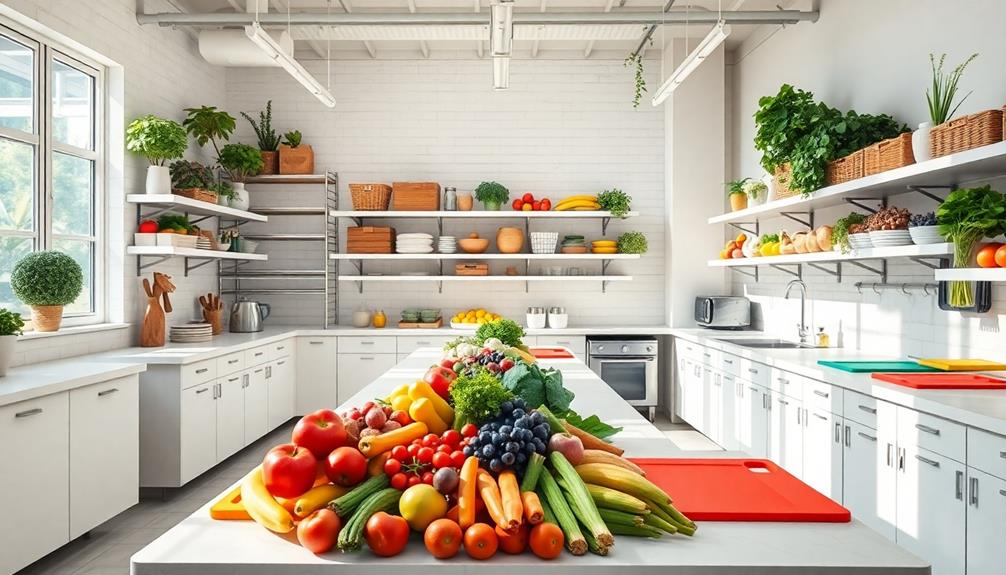
Creating an efficient workflow in your raw food kitchen can greatly enhance your cooking experience. Start by designing your kitchen layout around the food safety triangle, positioning the sink, preparation area, and stove within a four-meter perimeter. This minimizes cross-contamination risks while streamlining your workflow.
Next, designate specific zones for food storage, preparation, and cooking. This logical sequence helps your kitchen staff move seamlessly through tasks, reducing the chance of mistakes. Use vertical storage solutions, like shelves and racks, to keep frequently used tools and ingredients accessible, especially your food processor, which is essential for quick meal prep.
Implement a systematic storage approach by using labeled airtight containers for different types of raw ingredients. This organization not only maintains freshness but also guarantees you can quickly grab what you need, cutting down on prep time.
Lastly, make it a habit to regularly check and replenish pantry items. This prevents shortages and keeps your kitchen clutter-free, allowing for a smoother, more efficient cooking process.
Frequently Asked Questions
What Is the First Rule of Kitchen Safety?
The first rule of kitchen safety is preventing cross-contamination. You should always wash your hands before handling food, use separate cutting boards for raw and cooked items, and regularly clean surfaces to maintain a safe environment.
What Are 5 Safety Rules in the Kitchen Food?
In the kitchen, you should always wash your hands, use separate cutting boards for meats and veggies, maintain proper food temperatures, regularly clean surfaces, and manage waste effectively to guarantee a safe cooking environment.
How Can You Design a Kitchen for Safety?
To design a kitchen for safety, you should create zones for different tasks, position key areas within easy reach, use non-porous materials, and guarantee handwashing stations are accessible, minimizing contamination risks effectively.
Can the Layout of a Kitchen Prevent Food Poisoning?
Yes, the layout of your kitchen can prevent food poisoning. By minimizing distances between critical zones, ensuring easy access to sinks, and separating raw and cooked food areas, you enhance hygiene and reduce contamination risks considerably.
Conclusion
In your raw food kitchen, safety isn't just a rule; it's the foundation that allows creativity to flourish. Imagine your space as a well-tuned orchestra, where each design principle and safety measure plays in harmony. When you prioritize cleanliness and efficiency, you're not just cooking; you're crafting a delicious symphony of health. So, as you set up your kitchen, let safety be the bright beacon guiding you through the culinary adventure ahead.

